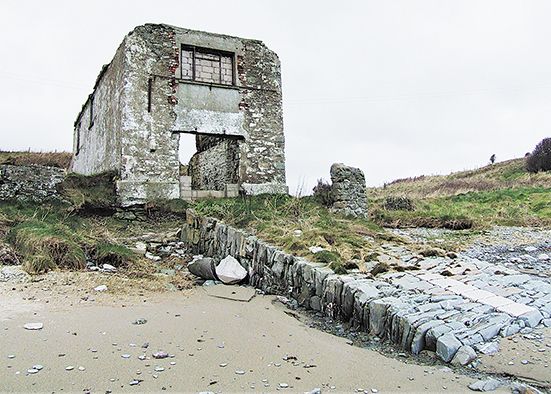Delving into past around Strangford
Delving into past around Strangford
7 September 2022

AN SOS has been sent out by a local history group which is tracing the history of the Coastguard service in the Strangford area.
Inverbrena Local History Group will be producing a book on the history of the Coastguard in the Strangford area, specifically the Strangford Division of the Coastguard, which encompassed Strangford, Killard, Gunn’s Island/Ballyhornan, Portaferry and Tara stations.
The project is being backed with funding from the Rural Community Network and from the Heritage Lottery Fund.
The history group would be delighted to hear from anyone who can supply information on the history of the Coastguard service and men within these areas, whether it’s of personal stories or memories of family members who were involved, or photos of people or buildings connected to the Coastguard.
The Coastguard service has its origins in the age-old battle against smugglers. Smuggling was a hugely lucrative trade in the 18th and 19th centuries, the contraband including such items as silks, spirits and, particularly tea, during the 18th century.
Measures to suppress the illicit trafficking of goods, especially tobacco in the 19th century, were often so inadequate that the Government was deprived of large amounts of revenue. To combat this illegal trade the Preventive Water Guard, the forerunner to the Coast Guard service, was established in stations around the coast.
The aim of the force was to prevent the landing of smuggled goods, whereby the arrangements made by the smugglers on shore may be defeated; the disposal of the tobacco, if ultimately landed, rendered difficult and dangerous, and the probability of catching the vessels crews and cargoes, by revenue cruisers or navy ships, materially increased.
Each station was furnished with two boats, arms and ammunition, in addition to other necessary stores, under the command of a chief officer, with accommodation provided for a detachment of men varying in numbers according to the nature of the coast.
Gunn’s Island station at Ballyhornan was established in 1821 and Dugald Molloy was a coastguardsman there in the 1850s.
Based on information retrieved from the 1911 census, it is known that Dugald, a Royal Navy pensioner, was born in Scotland while his wife, Mary, was born in County Louth. They were married for 59 years and of their 10 children one had died by the time of the 1911 census.
The couple met following Dugald’s posting to Gunn’s Island on February 3, 1852. The Coastguard records show that Dugald’s future father-in-law, James McDonald, was one of three permanent extra men at the Gunn’s Island station, having employed there from 1835. He retired in 1858 and died at Ballyhornan on July 18, 1882, with his daughter Rose Bryce present at his death. It’s quite probable that Dugald met Mary McDonald due to his acquaintance with her father.
Dugland and Mary were married on July 21, 1852, at Downpatrick Registrar’s office. Both the bride and the groom were residing in Ballyhornan at the time of their marriage.
Dugald had left Scotland for a life on the sea. Aged 21 he served aboard HMS Queen in 1842 as an ordinary seaman, the lowest rank of a ship’s deck crew which was an apprenticeship prior to reaching the rank of able-bodied seaman.
The ship, a 110-gun first-rate ship of the line of the Royal Navy, was ordered in 1827 under the name Royal Frederick but renamed in 1839 in honour of the then recently enthroned Queen Victoria.
In 1842 the ship received a visit from Queen Victoria whilst Dugald was stationed there. Dugald served as an able-bodied seaman aboard HMS Queen from 1843 to 1844 before serving aboard HMS Collingwood from 1844 to 1848.
From February to December 1849 he served on board the HMS Southampton, again as an able-bodied seaman, and from December 1849 until January 1852 he was captain of the fore top, a rank equivalent to that of petty officer.
In February 1852 Dugald’s rank altered to that of boatman, when he was sent to Gunn’s Island Coastguard station — a clear indication that he had transferred from the Royal Navy to the Coastguard.
All coastguards, except naval officers, entered as a ‘boatman’ irrespective of promotions previously achieved in the navy. It then became possible to progress through the ranks of ‘commissioned boatman’, then ‘chief boatman’ and possibly ‘chief boatman in charge’. From about 1860 some coastguardsmen were promoted to ‘chief officer 2nd class’.
Shortly after Dugald’s marriage he was transferred to Howth Coastguard station in Dublin as he had “married a native”, the implication being that he might therefore be tempted to collude with the locals in smuggling. Mary went with him as many of the Coastguard stations had living quarters to accommodate men with families as well as single men.
While located in Howth war broke out in the Crimea in October 1853 and the navy required additional men to supplement their numbers due to a manpower shortage. Since 1845 all recruits to the Coastguard had had to sign an agreement whereby they would serve aboard navy ships if required and approximately 2,600 entered the Fleet, returning to their regular duties when the war ceased.
Dugald’s service record indicates that on February 12, 1854, he was removed to serve as an able seaman aboard the Royal George, commanded by Capt Henry John Codrington, remaining there until May 4, 1856 — the war ended on March 31, 1856. For his services in the Crimean War, in the Baltic Sea theatre of operations against Russia, Dugald was awarded the Baltic Medal, a British Empire campaign medal.
Dugald returned to his Coastguard duties in May 1856 as a boatman and by 1861 he had been promoted to the post of commissioned boatman. In 1862 he was transferred to Cushendall and in 1865 to Ballintoy.
He was discharged from the Coastguard the following year, but was on board the HMS Hector until 1867. Dugald and his family eventually relocated to Ardglass following his discharge and settled there.
Anyone who would like to help the Inverbrena Local History Group with their project, which will be completed by January 31, 2023, or learn more about it, is asked to email Strangfordcoastguard@gmail.com.


